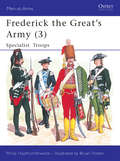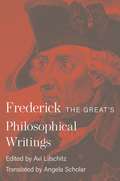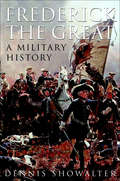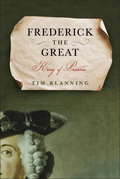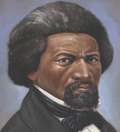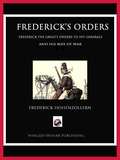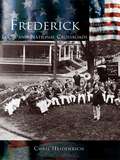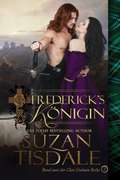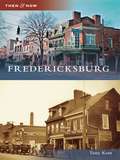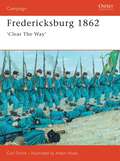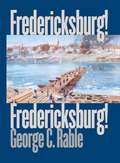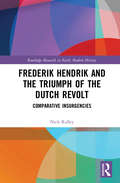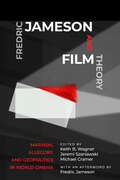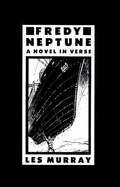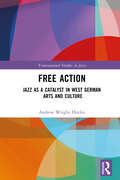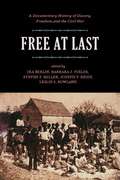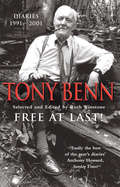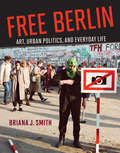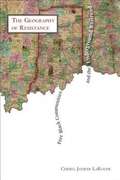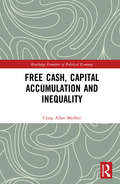- Table View
- List View
Frederick the Great's Army
by Bryan Fosten Philip HaythornthwaiteFrederick the Great was not renowned as a great artillery enthusiast, however he did recognise the importance of artillery and greatly expanded the arm. Frederick was also aware of the value of strong fortifications as barriers against the manoeuvres of enemy armies, and as places of security for troops and magazines; some of these were of vital significance in the survival of Prussia during the Seven Years' War (1756-1763). This fascinating volume by Philip Haythornwaite examines the artillery, engineers and others specialist troops of Frederick the Great's army.
Frederick the Great's Philosophical Writings
by King Frederick IIThe first modern English edition of diverse Enlightenment-era writings by Prussian monarch Frederick the GreatFrederick II of Prussia (1712–1786), best known as Frederick the Great, was a prolific writer of philosophical discourses, poems, epics, satires, and more, while maintaining extensive correspondence with prominent intellectuals, Voltaire among them. This edition of selected writings, the first to make a wide range of Frederick’s most important ideas available to a modern English readership, moves beyond traditional attempts to see his work only in light of his political aims. In these pages, we can finally appreciate Frederick’s influential contributions to the European Enlightenment—and his unusual role as a monarch who was also a published author.In addition to Frederick’s major opus, the Anti-Machiavel, the works presented here include essays, prefaces, reviews, and dialogues. The subjects discussed run the gamut from ethics to religion to political theory. Accompanied by critical annotations, the texts show that we can understand Frederick’s views of kingship and the state only if we engage with a broad spectrum of his thought, including his attitudes toward morality and self-love. By contextualizing his arguments and impact on Enlightenment beliefs, this volume considers how we can reconcile Frederick’s innovative public musings with his absolutist rule. Avi Lifschitz provides a robust and detailed introduction that discusses Frederick’s life and work against the backdrop of eighteenth-century history and politics.With its unparalleled scope and cross-disciplinary appeal, Frederick the Great’s Philosophical Writings firmly establishes one monarch’s multifaceted relevance for generations of readers and scholars to come.
Frederick the Great: A Military History (Modern Wars In Perspective Ser.)
by Dennis ShowalterA biography of the Prussian king and military legend from &“America&’s leading historian&” (Jeremy Black, author of Imperial Legacies). Famed for his military successes and domestic reforms, Frederick the Great was a remarkable leader whose campaigns were a watershed in the history of Europe, securing Prussia&’s place as a continental power and inaugurating a new pattern of total war that was to endure until 1916. However, much myth surrounds this enigmatic man, his personality, and his role as politician, warrior, and king. From a renowned military historian and winner of a Pritzker Literature Award, this book provides a refreshing, multidimensional depiction of Frederick the Great and an objective, detailed reappraisal of his military, political, and social achievements. Early chapters set the scene with an excellent summary of eighteenth-century Europe and the Age of Reason; an analysis of the character, composition, and operating procedures of the Prussian army; and an exploration of Frederick&’s personality as a young man. Later chapters examine his stunning victories at Rossbach and Leuthen; his defeats at Prague and Kolín; and Prussia&’s emergence as a key European power. Written with style and verve, this book offers brilliant insights into the political and military history of the eighteenth century—and one of history&’s most famous rulers.
Frederick the Great: A Military Life (Routledge Library Editions: Military and Naval History)
by Christopher DuffyFor tactical and strategic ingenuity, for daring and ruthless determination and the capacity to inspire troops, Frederick the Great was without equal. In this detailed life of ‘Old Fritz’, Christopher Duffy, who has written widely on the army of Frederick and on the armies of his adversaries, Austria and Russia, has produced a definitive account of his military genius.
Frederick the Great: King of Prussia
by Tim BlanningThe definitive biography of the legendary autocrat whose enlightened rule transformed the map of Europe and changed the course of history Few figures loom as large in European history as Frederick the Great. When he inherited the Prussian crown in 1740, he ruled over a kingdom of scattered territories, a minor Germanic backwater. By the end of his reign, the much larger and consolidated Prussia ranked among the continent's great powers. In this magisterial biography, award-winning historian Tim Blanning gives us an intimate, in-depth portrait of a king who dominated the political, military, and cultural life of Europe half a century before Napoleon. A brilliant, ambitious, sometimes ruthless monarch, Frederick was a man of immense contradictions. This consummate conqueror was also an ardent patron of the arts who attracted painters, architects, musicians, playwrights, and intellectuals to his court. Like his fellow autocrat Catherine the Great of Russia, Frederick was captivated by the ideals of the Enlightenment--for many years he kept up lively correspondence with Voltaire and other leading thinkers of the age. Yet, like Catherine, Frederick drew the line when it came to implementing Enlightenment principles that might curtail his royal authority. Frederick's terrifying father instilled in him a stern military discipline that would make the future king one of the most fearsome battlefield commanders of his day, while deriding as effeminate his son's passion for modern ideas and fine art. Frederick, driven to surpass his father's legacy, challenged the dominant German-speaking powers, including Saxony, Bavaria, and the Habsburg Monarchy. It was an audacious foreign policy gambit, one at which Frederick, against the expectations of his rivals, succeeded. In examining Frederick's private life, Blanning also carefully considers the long-debated question of Frederick's sexuality, finding evidence that Frederick lavished gifts on his male friends and maintained homosexual relationships throughout his life, while limiting contact with his estranged, unloved queen to visits that were few and far between. The story of one man's life and the complete political and cultural transformation of a nation, Tim Blanning's sweeping biography takes readers inside the mind of the monarch, giving us a fresh understanding of Frederick the Great's remarkable reign.
Frederick's Journey: The Life Of Frederick Douglass
by Doreen Rappaport London LaddFrederick Douglass was born a slave. He was taken from his mother as a baby, and separated from his grandparents when he was six. He suffered hunger and abuse, but miraculously, he learned how to read. Frederick read newspapers left in the street, and secretly collected spellings from neighborhood children. Words, he knew, would set him free. <p><p> When Frederick was twenty, he escaped to the North, where he spread his abolitionist beliefs through newspaper articles, autobiographies, and speeches. He believed that all people-regardless of color or gender-were entitled to equal rights. It is Douglass's words, as well as his life, that still provide hope and inspiration across generations.
Frederick's Orders: Frederick the Great's Orders to His Generals and His Way of War
by Vincent W Rospond Frederick HohenzollernAt various times in his military career Frederick the Great seemed on the cusp of a major defeat, yet always to find ways to extricate himself a secure a victory for himself and his lands. Frederick has long been considered in the pantheon of military leaders for his strategic and tactical prowess. His instructions to his generals have long been considered a starting point to understand the military mind of this leader. We present an annotated and illustrated version of Frederick the Great's 1754 Instructions to his infantry and cavalry. Included in this volume are maps that provide a background to his battles, a biography of Frederick and some of his generals, and an explanation of 18th century warfare as well as illustrations of his troops.
Frederick: Local and National Crossroads
by Chris HeidenrichFrederick has stood as the gateway to western Maryland since the 1740s, when German and English settlers moved into the area seeking fertile farmland. Site of the first official rebellious act of the American colonies, early Frederick Town shared the fortunes of the growing nation as proximity to the new capital in Washington and the port of Baltimore fed industry and culture here along the Monocacy River.
Fredericks Königin
by Angelika Dürre Suzan TisdaleOhne Dunkelheit kann es kein Licht geben, keine Hoffnung ohne Verzweiflung, keine Liebe ohne Herzschmerz Manche Narben sind unsichtbar Als der gutaussehende Frederick Mackintosh anbietet, Aggie McLaren zu heiraten, ist sie sicher, dass entweder Gier oder Wahnsinn ihn dazu treiben. Sie glaubt, dass sie ihm nichts zu bieten hat, außer Land und die Chance, die Stellung des Chiefs einzunehmen. Sie erfährt schon bald, dass dies keinesfalls der Wahrheit entspricht. Durch die Güte, Ehre und wilde Entschlossenheit ihres Mannes, ihre Ehe und ihren Clan zum Erfolg zu führen, blüht verloren geglaubte Hoffnung in ihr auf. Manchmal ist Vollkommenheit unvollkommen Aggie McLaren entspricht nicht Frederick Mackintoshs Bild der perfekten Frau. Sie ist weder belesen noch temperamentvoll oder sinnlich. Sie ist klein, zart und nicht in der Lage zu sprechen. Ihr Lächeln und die Chance, Chief zu werden, treiben ihn dazu, um ihre Hand anzuhalten. Frederick wird alles in seiner Macht Stehende tun, um sie wieder lächeln zu sehen und ihr zu helfen, ihre Stimme zurückzugewinnen.
Fredericksburg (Then and Now)
by Tony KentFredericksburg, one of America's most historic cities, sits midpoint between the nation's capital and Richmond. Many visitors come to this city to walk in the footsteps of illustrious Americans, admire their homes, view the battlefields nearby, and enjoy true Southern hospitality. Following a broadcasting career in California and New York, author Tony Kent retired to Fredericksburg where he and 12 others founded the Central Rappahannock Heritage Center, a regional archive for the grass roots history of the city and its four neighboring counties. Many never-before-published images in this volume are from the center's collection.
Fredericksburg 1862
by Carl Smith Adam HookOsprey's examination of the Battle of Fredericksburg of the American Civil War (1861-1865). In December 1862, things were still confused for the Union. Antietam had been a failure for both sides, and although the battle showed that the Union army could bring the Confederates to bay, it couldn't pin them in one place long enough to destroy them. In December 1862, General Burnside, newly appointed to command the Army of the Potomac, planned to seize and secure the town of Fredericksburg, and then take the Confederate capital of Richmond. Carl Smith's book details the epic struggle that engulfed the Union side as it crossed the Rappahannock on December 11, encountering stiff opposition from Lee's men.
Fredericksburg Staff Ride: Briefing Book [Illustrated Edition]
by Ted Ballard Billy ArthurContains more than 20 maps, diagrams and illustrationsThe movement and details of the Union offensive plan at Fredericksburg seemed to be understood by all senior commanders; the North had a preponderance of manpower and artillery; a bridgehead was established on the enemy side of the river and initial objectives secured. Why did Burnside decide to withdraw his army back across the river to its original position? That question cannot be answered without viewing the pontoon crossing sites, the Union approach routes, the infamous "stonewall," and the other Confederate defensive positions. Accordingly, the purpose of a Fredericksburg staff ride is to visit these and other locations on the battlefield and analyze the battle through the eyes of the men who were there, both leaders and rank and file soldiers.
Fredericksburg! Fredericksburg!
by George C. RableDuring the battle of Gettysburg, as Union troops along Cemetery Ridge rebuffed Pickett's Charge, they were heard to shout, "Give them Fredericksburg!" Their cries reverberated from a clash that, although fought some six months earlier, clearly loomed large in the minds of Civil War soldiers. Fought on December 13, 1862, the battle of Fredericksburg ended in a stunning defeat for the Union. Confederate general Robert E. Lee suffered roughly 5,000 casualties but inflicted more than twice that many losses--nearly 13,000--on his opponent, General Ambrose Burnside. As news of the Union loss traveled north, it spread a wave of public despair that extended all the way to President Lincoln. In the beleaguered Confederacy, the southern victory bolstered flagging hopes, as Lee and his men began to take on an aura of invincibility. George Rable offers a gripping account of the battle of Fredericksburg and places the campaign within its broader political, social, and military context. Blending battlefield and home front history, he not only addresses questions of strategy and tactics but also explores material conditions in camp, the rhythms and disruptions of military life, and the enduring effects of the carnage on survivors--both civilian and military--on both sides.
Fredericksburg, 1862: A Study Of War [illustrated Edition] (Special Campaigns Series #3)
by Major George William RedwayThis ebook is purpose built and is proof-read and re-type set from the original to provide an outstanding experience of reflowing text for an ebook reader. Includes Civil War Map and Illustrations Pack - 224 battle plans, campaign maps, and detailed analyses of actions spanning the entire period of hostilities. Major Redway picks up his analysis of the actions in the Eastern theatre of the Civil War with his widely acclaimed book on the Fredericksburg campaign of 1862. Goaded by his political master Lincoln, Major-General Burnside assumed the offensive with the Union army in late 1862, planning to use speed and surprise to enable him to defeat the Confederate forces under Robert E. Lee. His plan started to fall apart almost immediately as he failed to move with the requisite speed and, faced with choices between vaciliation and bold action, assumed the former. What had started badly was to end disastrously for the Union forces at the Battle of Fredericksburg, as bloody frontal assaults were delivered against entrenched Confederate troops. This book is part of the Special Campaigns series produced around the turn of the 20th century by serving or recently retired British and Indian Army officers. They were intended principally for use by British officers seeking a wider knowledge of military history. Title - Fredericksburg, 1862 : A Study of War Series Name - Special Campaigns Series Series Number --3 Author -- Major George William Redway (1859-1934) Text taken, whole and complete, from the edition published in 1906, London, by Swan Sonnenschein & Co. Original - xv and 297 pages. Illustrations - The maps cannot be reproduced with this volume as they are A3 - 224 additional maps have been added.
Fredericksburg, Virginia: Eclectic Histories for the Curious Reader
by Ted KamieniakTed Kamieniak collected these fifteen superb articles to amaze and fascinate all who feel "history" is simply a well-worn path. Each selection delivers fresh perspective andintriguing events connected to Fredericksburg and Spotsylvania County, Virginia.Fastidiously investigated and painstakingly written, thiseclectic compilation presents little-visited neighborhoodsof historical inquiry. Meet Fredericksburg's first cop on thebeat; discover the persistence of hoodoo and conjurationin black plantation society; delve into the account of StateSenator Benjamin Pitts and Fredericksburg's first drive-inmovie theater--and so much more! Whether your interests lie in social history, vernacular architecture, historic technology or folkways, you will find this book an entertaining and profitable read.
Frederik Hendrik and the Triumph of the Dutch Revolt: Comparative Insurgencies
by Nick RidleyFrederik Hendrik and the Triumph of the Dutch Revolt describes a crucial period in European history. During the early seventeenth century the Dutch, led by Frederik Hendrik, were engaged in a struggle for independence from the mighty Spanish Empire. But Spain was allied with its fellow Hapsburg power, the Holy Roman Empire, and Europe was convulsed with the Thirty Years’ War. It was a turbulent time with complex diplomacy, shifting alliances, monumental battles and more European powers entering the war. Yet thanks to Frederik Hendrik’s adroit diplomacy and military skill, combined with the tenacity of the Dutch people, the Dutch Republic emerged from the conflicts and gained full independence, eventually becoming a significant European power. After tracing these developments, the book continues by examining and comparing later nationalist insurgencies in the late twentieth and twenty-first centuries. It analyses and identifies the factors making for successful insurgencies. The key factors of finances and international relations are emphasised. This volume is informative and compelling reading for both practitioners and students studying history, international relations, terrorism and insurgency.
Fredric Jameson and Film Theory: Marxism, Allegory, and Geopolitics in World Cinema
by John Mackay Dudley Andrew Jeremi Szaniawski Fredric Jameson Pansy Duncan Michael Cramer Paul Coates Dan Hassler-Forest Naoki Yamamoto Mike Wayne Keith B. Wagner Alvin K. Wong Mercedes VazquezFrederic Jameson and Film Theory is the first collection of its kind, it assesses and critically responds to Fredric Jameson’s remarkable contribution to film theory. The essays assembled explore key Jamesonian concepts—such as totality, national allegory, geopolitics, globalization, representation, and pastiche—and his historical schema of realism, modernism, and postmodernism, considering, in both cases, how these can be applied, revised, expanded and challenged within film studies. Featuring essays by leading and emerging voices in the field, the volume probes the contours and complexities of neoliberal capitalism across the globe and explores world cinema's situation within these forces by deploying and adapting Jamesonian concepts, and placing them in dialogue with other theoretical paradigms. The result is an innovative and rigorously analytical effort that offers a range of Marxist-inspired approaches towards cinemas from Asia, Latin America, Europe, and North America in the spirit of Jameson's famous rallying cry: 'always historicize!'.
Fredy Neptune: A Novel In Verse
by Les MurrayA riveting, beautiful novel in verse by Australia's greatest contemporary poet, winner of the 1996 T. S. Eliot Prize. I never learned the old top ropes, I was always in steam. Less capstan, less climbing, more re-stowing cargo. Which could be hard and slow as farming- but to say Why this is Valparaiso! Or: I'm in Singapore and know my way about takes a long time to get stale. -from Book I, "The Middle Sea" When German-Australian sailor Friedrich "Fredy" Boettcher is shanghaied aboard a German Navy battleship at the outbreak of World War I, the sight of frenzied mobs burning Armenian women to death in Turkey causes him, through moral shock, to lose his sense of touch. This mysterious disability, which he knows he must hide, is both protection and curse, as he orbits the high horror and low humor of a catastrophic age. Told in a blue-collar English that regains freshness by eschewing the mind-set of literary language, Fredy's picaresque life - as, perhaps, the only Nordic Superman ever - is deep-dyed in layers of irony and attains a mind-inverting resolution.
Free Action: Jazz as a Catalyst in West German Arts and Culture (Transnational Studies in Jazz)
by Andrew Wright HurleyAdvancing the New Jazz Studies by focusing on questions of intermediality and cultural catalysis, this book demonstrates the role jazz played in the re-making of West German culture in the post-war era.The shadow of National Socialism, a history of German polarisation by jazz, and the influences of occupation and division, meant that jazz catalysed influential young creative artists. These included writers such as Nobel Laureate Günter Grass, Young German Cinema filmmakers like Hansjürgen Pohland, and abstract visual artists like KRH Sonderborg. Jazz provided an impulse to take into extra-musical artforms, and an impetus to reflect on what art and culture were. Through considering poetry, the novel, photography, film and television, graphic design and the fine arts, this volume reveals how German creatives were influenced not only by American jazz culture, but also by cultural innovations from elsewhere, and by German traditions they considered less compromised by the Nazi era. The book also explores the limits of this catalysis, examining for example how African-Americans received the German representation of jazz culture.Written in an accessible style, this important contribution to New Jazz Studies and German Studies scholarship will appeal to both graduate and undergraduate students or researchers in the fields of jazz history, twentieth-century musicology, and European or German cultural studies.
Free At Last: A Documentary History Of Slavery, Freedom, And The Civil War
by Ira Berlin Barbara J. Fields Steven F. Miller Joseph P. Reidy Leslie S. Rowland"Free at Last" brings together some of the most remarkable letters ever written by Americans. Made affordable and widely available for the first time, these letters, along with personal testimony, official transcripts, and other records, are drawn from the award-winning landmark reference volumes originally published by Cambridge University Press under the title "Freedom: A Documentary History of Emancipation." With great immediacy, the letters depict the drama of emancipation in the midst of the nation's bloodiest conflict, and convey the struggle of black men and women to overthrow the slave system, to aid the Union cause as laborers and soldiers, and to give meaning to their newly won freedom in a war-torn nation. The documents also show the active role of slaves and former slaves in transforming a war for the Union into a war against slavery, demonstrating, according to the "Journal of American History," "that the destruction of slavery was accomplished through black self-determination." Perhaps most importantly, the documents vividly demonstrate how emancipation transformed the lives of all Americans, black and white.
Free At Last: Diaries 1991 - 2001
by Tony BennTony Benn is the longest serving MP in the history of the Labour Party. He left Parliament in 2001, after more than half a century in the House of Commons, to devote more time to politics. This volume of his Diaries describes and comments, in a refreshing and honest way, upon the events of a momentous decade including two world wars, a change of government in Britain and the emergence of New Labour, of which he makes clear he is not a member. Tony Benn's account is a well documented, formidable and principled critique of the New Labour Project, full of drama, opinion, humour, anecdotes and sparkling pen-portraits of politicians on both sides of the political divide. But his narrative is also broader and more revealing about day-to-day political life, covering many aspects normally disregarded by historians and lobby correspondents, relating to his work in the constituency, including his advice surgeries. This volume also offers far more of an insight into Tony Benn's personal life, his thoughts about the future and his relationship with his family, especially his remarkable wife Caroline, whose illness and death overshadow these years. Tony Benn is a unique figure on the British political landscape: a true democrat, a passionate socialist and diarist without equal. With this volume, his published Diaries cover British politics for over sixty years. It is edited, as are all others, by Ruth Winstone.
Free Berlin: Art, Urban Politics, and Everyday Life
by Briana J. SmithAn alternative history of art in Berlin, detaching artistic innovation from art world narratives and connecting it instead to collective creativity and social solidarity.In pre- and post-reunification Berlin, socially engaged artists championed collective art making and creativity over individual advancement, transforming urban space and civic life in the process. During the Cold War, the city&’s state of exception invited artists on both sides of the Wall to detour from artistic tradition; post-Wall, art became a tool of resistance against the orthodoxy of economic growth. In Free Berlin, Briana Smith explores the everyday peculiarities, collective joys, and grassroots provocations of experimental artists in late Cold War Berlin and their legacy in today&’s city.These artists worked intentionally outside the art market, believing that art should be everywhere, freed from its confinement in museums and galleries. They used art as a way to imagine new forms of social and creative life. Smith introduces little-known artists including West Berlin feminist collective Black Chocolate, the artist duo paint the town red (p.t.t.r), and the Office for Unusual Events, creators of satirical urban political theater, as well as East Berlin action art and urban interventionists Erhard Monden, Kurt Buchwald, and others. Artists and artist-led urban coalitions in 1990s Berlin carried on the participatory spirit of the late Cold War, with more overt forms of protest and collaboration at the neighborhood level. The temperament lives on in twenty-first century Berlin, animating artists&’ resolve to work outside the market and citizens&’ spirited defenses of green spaces, affordable housing, and collectivist projects. With Free Berlin, Smith offers an alternative history of art in Berlin, detaching artistic innovation from art world narratives and connecting it instead to Berliners&’ historic embrace of care, solidarity, and cooperation.
Free Black Communities and the Underground Railroad: The Geography of Resistance
by Cheryl Janifer LarocheThis enlightening study employs the tools of archaeology to uncover a new historical perspective on the Underground Railroad. Unlike previous histories of the Underground Railroad, which have focused on frightened fugitive slaves and their benevolent abolitionist accomplices, Cheryl LaRoche focuses instead on free African American communities, the crucial help they provided to individuals fleeing slavery, and the terrain where those flights to freedom occurred. This study foregrounds several small, rural hamlets on the treacherous southern edge of the free North in Illinois, Indiana, and Ohio. LaRoche demonstrates how landscape features such as waterways, iron forges, and caves played a key role in the conduct and effectiveness of the Underground Railroad. Rich in oral histories, maps, memoirs, and archaeological investigations, this examination of the "geography of resistance" tells the new powerful and inspiring story of African Americans ensuring their own liberation in the midst of oppression.
Free Cash, Capital Accumulation and Inequality (Routledge Frontiers of Political Economy)
by Craig Allan MedlenInvestment is the engine of growth. In consequence, the social welfare of the populace depends on the expectations of uncertain profitability as understood by the agents of a wealthy few who decide upon levels of investment. As private wealth is intimately tied to the investment process, the importance of wealth concentration goes far beyond considerations of equity. In recent years, private economic power has become increasingly concentrated as more of the population has become dependent upon an elite pursuing private ends. In this context, this book examines the role of capital accumulation in various historical contexts. Over seventy years ago, Michal Kalecki derived the mathematical relationship between government deficits, the external trade account and free cash—defined as the gross profit over and above that portion ploughed back into new investment. Since then, the free cash literature has remained largely within an industrial organizational context where free cash theory has helped to explain mergers. In contrast, this book, revisits Kalecki’s free cash construction at the macro and global level and explores the various causes and effects of free cash on the economy. As part of this examination, the author highlights the historical uses of free cash in imperialist adventures, mergers and speculative endeavours. In addition to developing a new relative valuation measure of capital accumulation, he also utilizes a neo-Kaleckian model to help explain the U.S. slowdown in investment since the late 1960s, the increasing inequality of wealth and income and the recent speculative episodes associated with the spillage of free cash. Finally, based on these models the book argues for heightened taxes on the wealthy and an increased role for government investment in health care and energy. Free Cash, Capital Accumulation and Inequality offers an explanation as to how wealth and income inequalities have fashioned, and been fashioned by, various historical episodes right up to the present. It will be of great interest to those studying and researching in the field of economic analysis.
Free City!: The Fight for San Francisco's City College and Education for All
by Mickey Ellinger; Vicki Legion; Marcy ReinIn 2012, the accreditor sanctioned City College of San Francisco, one of the biggest and best community colleges in the country, and a year later proposed terminating its accreditation, leading to a state takeover. Free City! follows the multipronged strategies of the campaign and the diverse characters that carried them out. Teachers, students, labor unions, community groups, public officials, and concerned individuals saved a treasured public institution as San Francisco's working-class communities of color battled the gentrification that was forcing them out of the city. And they pushed back against the national "reform" agenda of corporate workforce training that drives students towards debt and sidelines lifelong learning and community service programs. Combining analysis with narrative, Free City! offers a case study in the power of positive vision and solution-oriented organizing and a reflection on what education can and should be.
